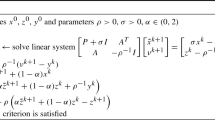Abstract
We introduce a new relaxation framework for nonconvex quadratically constrained quadratic programs (QCQPs). In contrast to existing relaxations based on semidefinite programming (SDP), our relaxations incorporate features of both SDP and second order cone programming (SOCP) and, as a result, solve more quickly than SDP. A downside is that the calculated bounds are weaker than those gotten by SDP. The framework allows one to choose a block-diagonal structure for the mixed SOCP-SDP, which in turn allows one to control the speed and bound quality. For a fixed block-diagonal structure, we also introduce a procedure to improve the bound quality without increasing computation time significantly. The effectiveness of our framework is illustrated on a large sample of QCQPs from various sources.





Similar content being viewed by others
References
Burer, S., Monteiro, R.: A nonlinear programming algorithm for solving semidefinite programs via low-rank factorization. Math. Program., Ser. B 95, 329–357 (2003)
de Klerk, E., Sotirov, R.: Exploiting group symmetry in semidefinite programming relaxations of the quadratic assignment problem. Math. Program., Ser. A 122(2), 225–246 (2010)
Fujie, T., Kojima, M.: Semidefinite programming relaxation for nonconvex quadratic programs. J. Glob. Optim. 10(4), 367–380 (1997)
Fukuda, M., Kojima, M., Murota, K., Nakata, K.: Exploiting sparsity in semidefinite programming via matrix completion. I. General framework. SIAM J. Optim. 11(3), 647–674 (2000)
See the website: www.gamsworld.org/global/globallib/globalstat.htm
Goemans, M., Williamson, D.: Improved approximation algorithms for maximum cut and satisfiability problems using semidefinite programming. J. ACM 42, 1115–1145 (1995)
Grone, R., Johnson, C., Sá, E., Wolkowicz, H.: Positive definite completions of partial Hermitian matrices. Linear Algebra Appl. 58, 109–124 (1984)
Helmberg, C., Rendl, F.: A spectral bundle method for semidefinite programming. SIAM J. Optim. 10, 673–696 (2000)
Kim, S., Kojima, M.: Second order cone programming relaxation of nonconvex quadratic optimization problems. Optim. Methods Softw. 15(3–4), 201–224 (2001)
Kojima, M., Tunçel, L.: Cones of matrices and successive convex relaxations of nonconvex sets. SIAM J. Optim. 10(3), 750–778 (2000)
Lasserre, J.B.: Global optimization with polynomials and the problem of moments. SIAM J. Optim. 11(3), 796–817 (2001)
Laurent, M., Rendl, F.: Semidefinite programming and integer programming. In: Karen Aardal, R.W., Nemhauser, G. (eds.) Handbook on Discrete Optimization, pp. 393–514. Elsevier, Amsterdam (2005)
Lovász, L., Schrijver, A.: Cones of matrices and set-functions and 0-1 optimization. SIAM J. Optim. 1, 166–190 (1991)
Monteiro, R.D.C.: First- and second-order methods for semidefinite programming. Math. Program. 97, 209–244 (2003)
Nakata, K., Fujisawa, K., Fukuda, M., Kojima, M., Murota, K.: Exploiting sparsity in semidefinite programming via matrix completion. II. Implementation and numerical results. Math. Program., Ser. B 95(2), 303–327 (2003). Computational semidefinite and second order cone programming: the state of the art
Rendl, F., Rinaldi, G., Wiegele, A.: Solving Max-Cut to optimality by intersecting semidefinite and polyhedral relaxations. Math. Program. 121(2), 307 (2010)
Saxena, A., Bonami, P., Lee, J.: Convex relaxations of non-convex mixed integer quadratically constrained programs: projected formulations. Math. Program. (2010). doi:10.1007/s10107-010-0340-3
Sherali, H.D., Adams, W.P.: A Reformulation-Linearization Technique for Solving Discrete and Continuous Nonconvex Problems. Kluwer, Dordrecht (1997)
Zhao, X., Sun, D., Toh, K.: A Newton-CG augmented Lagrangian method for semidefinite programming. SIAM J. Optim. 20, 1737–1765 (2010)
Zheng, X., Sun, X., Li, D.: Nonconvex quadratically constrained quadratic programming: best d.c. decompositions and their sdp representations. J. Glob. Optim. 50, 695–712 (2011)
Author information
Authors and Affiliations
Corresponding author
Additional information
The research of S. Burer was supported in part by NSF Grant CCF-0545514. The research of S. Kim was supported by NRF 2012-R1A1A2-038982 and NRF 2010-000-8784. The research of M. Kojima was partially supported by the Japan Science and Technology Agency (JST), the Core Research of Evolutionary Science and Technology (CREST) Research Project.
Rights and permissions
About this article
Cite this article
Burer, S., Kim, S. & Kojima, M. Faster, but weaker, relaxations for quadratically constrained quadratic programs. Comput Optim Appl 59, 27–45 (2014). https://doi.org/10.1007/s10589-013-9618-8
Received:
Published:
Issue Date:
DOI: https://doi.org/10.1007/s10589-013-9618-8




